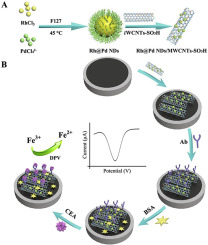当前位置:
X-MOL 学术
›
Anal. Chim. Acta
›
论文详情
Our official English website, www.x-mol.net, welcomes your feedback! (Note: you will need to create a separate account there.)
The label-free immunosensor based on rhodium@palladium nanodendrites/sulfo group functionalized multi-walled carbon nanotubes for the sensitive analysis of carcino embryonic antigen
Analytica Chimica Acta ( IF 6.2 ) Pub Date : 2018-05-01 , DOI: 10.1016/j.aca.2017.12.030 Hui Lv , Yueyun Li , Xiaobo Zhang , Zengqiang Gao , Jinhui Feng , Ping Wang , Yunhui Dong
Analytica Chimica Acta ( IF 6.2 ) Pub Date : 2018-05-01 , DOI: 10.1016/j.aca.2017.12.030 Hui Lv , Yueyun Li , Xiaobo Zhang , Zengqiang Gao , Jinhui Feng , Ping Wang , Yunhui Dong

|
In this work, bimetallic core-shell rhodium@palladium nanodendrites (Rh@Pd NDs) loaded on sulfo group functionalized multi-walled carbon nanotubes (MWCNTs-SO3H) were combined to form Rh@Pd NDs/MWCNTs-SO3H nanocomposites. And the composites were used to construct a simple and label-free electrochemical immunosensor for carcino embryonic antigen (CEA) detection using differential pulse voltammetry (DPV). Rh@Pd NDs with dendritic nanostructure not only provide abundant catalytically active sites, but also increase the loading of antibody, which could improve the analytical performance and result in high sensitivity. In addition, the MWCNTs-SO3H could further enhance electrochemical properties due to the excellent conductivity, good solubility and high surface area. Taking advantages of both Rh@Pd NDs and MWCNTs-SO3H, the proposed immunosensor showed a broad linear range from 25 fg mL-1 to 100 ng mL-1 for CEA detection and a low detection limit of 8.3 fg mL-1 (signal-to-noise ratio of 3) under optimal experimental conditions. Moreover, the expected immunosensor exhibited good reproducibility and high sensitivity, which could achieve excellent analysis of CEA in human serum with satisfactory results. Therefore, the Rh@Pd NDs/MWCNTs-SO3H nanocomposites may be considered as a sensing platform for fabrication of simple, ultrasensitive and label-free electrochemical immunosensor.
中文翻译:

基于铑@钯纳米枝晶/磺基官能化多壁碳纳米管的无标记免疫传感器用于癌胚抗原的灵敏分析
在这项工作中,负载在磺基官能化多壁碳纳米管(MWCNTs-SO3H)上的双金属核壳铑@钯纳米枝晶(Rh@Pd NDs)结合形成Rh@Pd NDs/MWCNTs-SO3H纳米复合材料。并使用复合材料构建了一种简单且无标记的电化学免疫传感器,用于使用差分脉冲伏安法 (DPV) 检测癌胚抗原 (CEA)。具有树枝状纳米结构的 Rh@Pd NDs 不仅提供了丰富的催化活性位点,而且增加了抗体的负载量,这可以提高分析性能并导致高灵敏度。此外,MWCNTs-SO3H由于具有优异的导电性、良好的溶解性和高表面积,可以进一步提高电化学性能。利用 Rh@Pd NDs 和 MWCNTs-SO3H,在最佳实验条件下,所提出的免疫传感器显示出从 25 fg mL-1 到 100 ng mL-1 的广泛线性范围,用于 CEA 检测和 8.3 fg mL-1(信噪比为 3)的低检测限。此外,预期的免疫传感器具有良好的重现性和高灵敏度,可以对人血清中的 CEA 进行出色的分析,并获得令人满意的结果。因此,Rh@Pd NDs/MWCNTs-SO3H 纳米复合材料可被视为制造简单、超灵敏和无标记电化学免疫传感器的传感平台。可对人血清中的 CEA 进行出色的分析,并获得满意的结果。因此,Rh@Pd NDs/MWCNTs-SO3H 纳米复合材料可被视为制造简单、超灵敏和无标记电化学免疫传感器的传感平台。可对人血清中的 CEA 进行出色的分析,并获得满意的结果。因此,Rh@Pd NDs/MWCNTs-SO3H 纳米复合材料可被视为制造简单、超灵敏和无标记电化学免疫传感器的传感平台。
更新日期:2018-05-01
中文翻译:

基于铑@钯纳米枝晶/磺基官能化多壁碳纳米管的无标记免疫传感器用于癌胚抗原的灵敏分析
在这项工作中,负载在磺基官能化多壁碳纳米管(MWCNTs-SO3H)上的双金属核壳铑@钯纳米枝晶(Rh@Pd NDs)结合形成Rh@Pd NDs/MWCNTs-SO3H纳米复合材料。并使用复合材料构建了一种简单且无标记的电化学免疫传感器,用于使用差分脉冲伏安法 (DPV) 检测癌胚抗原 (CEA)。具有树枝状纳米结构的 Rh@Pd NDs 不仅提供了丰富的催化活性位点,而且增加了抗体的负载量,这可以提高分析性能并导致高灵敏度。此外,MWCNTs-SO3H由于具有优异的导电性、良好的溶解性和高表面积,可以进一步提高电化学性能。利用 Rh@Pd NDs 和 MWCNTs-SO3H,在最佳实验条件下,所提出的免疫传感器显示出从 25 fg mL-1 到 100 ng mL-1 的广泛线性范围,用于 CEA 检测和 8.3 fg mL-1(信噪比为 3)的低检测限。此外,预期的免疫传感器具有良好的重现性和高灵敏度,可以对人血清中的 CEA 进行出色的分析,并获得令人满意的结果。因此,Rh@Pd NDs/MWCNTs-SO3H 纳米复合材料可被视为制造简单、超灵敏和无标记电化学免疫传感器的传感平台。可对人血清中的 CEA 进行出色的分析,并获得满意的结果。因此,Rh@Pd NDs/MWCNTs-SO3H 纳米复合材料可被视为制造简单、超灵敏和无标记电化学免疫传感器的传感平台。可对人血清中的 CEA 进行出色的分析,并获得满意的结果。因此,Rh@Pd NDs/MWCNTs-SO3H 纳米复合材料可被视为制造简单、超灵敏和无标记电化学免疫传感器的传感平台。


























 京公网安备 11010802027423号
京公网安备 11010802027423号